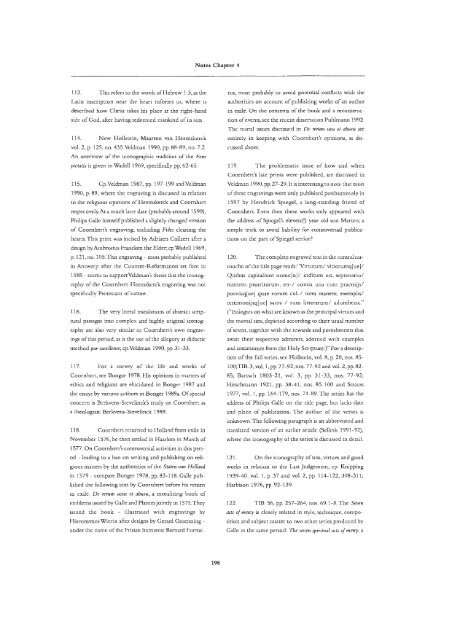manfred sellink philips galle - VU-DARE Home
manfred sellink philips galle - VU-DARE Home
manfred sellink philips galle - VU-DARE Home
Create successful ePaper yourself
Turn your PDF publications into a flip-book with our unique Google optimized e-Paper software.
113. This refers 10 the words of Hebrew 1:3, as the<br />
Latin inscription near the heart informs us, where is<br />
described how Christ takes his place at the right-hand<br />
side of God, after having redeemed mankind of its sins.<br />
114. New Hollstem, Maarten van Heemskerck<br />
vol. 2, p. 125, no. 435-Veldman 1990, pp. 88-89, no. 7.2.<br />
An overview of die iconographic tradition of the Forts<br />
pieiatis is given in Wadell 1969, specifically pp. 62-65.<br />
115. Cp.Veldm.an 1987, pp. 197-199 and Veldrnan<br />
1990, p. 89, where the engraving is discussed in relation<br />
to the religious opinions of Heemskerck and Coornhert<br />
respectively.At a much later date (probably around 1590),<br />
Philips Galle himself published a slightly changed version<br />
of Coornhert's engraving, including Fides cleaning the<br />
hearts. This print was incised by Adriaen Collaert after a<br />
design by Ambrosius Francken the Elder; cp.Wadell 1969,<br />
p. 121, no. 105.This engraving - most probably published<br />
in Antwerp after the Counter-Reformation set foot in<br />
1585 - seems to support Veldrnan s thesis that the iconog<br />
raphy of the Coornhert- Heemskerck engraving was not<br />
specifically Protestant of nature.<br />
116. The very literal translations of abstract scrip<br />
tural passages into complex and highly original iconog<br />
raphy are also very similar to Coornhert's own engrav<br />
ings of this period, as is the use of the allegory as didactic<br />
method par excellence; cp.Veldrnan 1990, pp 31-33.<br />
117. For a survey of the life and works of<br />
Coornhert, see Bonger 1978. His opinions in matters of<br />
ethics and religions are elucidated in Bonger 1987 and<br />
the essays by various authors in Bonger 1989a. Of special<br />
concern is Berkvens-Stevelinck s study on Coornhert as<br />
a theologian: Berkvens-Stevelinck 1989.<br />
118. Coornhert returned to Holland from exile in<br />
November 1576, he then settled in Haarlem in March of<br />
1577. On Coornhert's controversial activioes in this peri<br />
od - leading to a ban on writing and publishing on reli<br />
gious matters by the authorities of the Staten van Holland<br />
in 1579 - compare Bonger 1978, pp. 83-118. Galle pub<br />
lished the following text by Coornhert before his return<br />
to exile: De return usus et abusu, a moralizing book of<br />
emblems issued by Galle and Plantin jointly in 1575.They<br />
issued the book - illustrated with engravings by<br />
Hieronyrnus Wierix after designs by Gerard Groenning -<br />
under the name of the Frisian humanist Bernard Fur me -<br />
Notes Chapter 4<br />
198<br />
rus, most probably to avoid potential conflicts with die<br />
authorities on account of publishing works of an author<br />
in exile. On the contents of the book and a reconstruc<br />
tion of events, see the recent dissertation Puhlmann 1992.<br />
The moral issues discussed in De rerum usu et abusu are<br />
entirely in keeping with Coornhert's opinions, as dis<br />
cussed above.<br />
119. The problematic issue of how and when<br />
Coornhert's late prints were published, are discussed in<br />
Veldrnan 1990, pp. 27-29. It is interestmg to note that most<br />
of these engravings were only published posthumously in<br />
1597 by Hendrick Spiegel, a long-standing friend of<br />
Coornhert. Even then these works only appeared with<br />
the address of Spiegel's eleven (!) year old son Marten; a<br />
simple trick to avoid liability for controversial publica<br />
tions on the part of Spiegel senior?<br />
120. The complete engraved text in the central car<br />
touche of the title page reads: "Virtutum/ viuorumq[ue]/<br />
Quibus capitaliurn nomejn]/ inditum est, septenario/<br />
numero prorxitorum, en-/ comia una com praemijs/<br />
poenisq[ue] quae eorurn cul-/ tores manent, exemplis/<br />
testimonijsq[ue] sacra-/ rum litterarum/ adumbrata."<br />
("Eulogies on what are known as the principal virtues and<br />
the mortal sins, depicted according to their usual number<br />
of seven, together with the rewards and punishments that<br />
await their respective admirers, adorned with examples<br />
and testimonies from the Holy Scripture.)" For a descrip<br />
tion of the full series, see Hollstein, vol. 8, p. 20, nos. 85-<br />
100;TIB. 3, vol. 1, pp. 77-92, nos. 77-92 and vol. 2, pp. 82-<br />
85; Bartsch 1803-21, vol. 3, pp. 31-33, nos. 77-92;<br />
Hirschrnann 1921, pp. 38-41, nos. 85-100 and Strauss<br />
1977, vol. 1, pp. 164-179, nos. 74-89. The series has the<br />
address of Philips Galle on the title page, but lacks date<br />
and place of publication. The author of the verses is<br />
unknown.The following paragraph is an abbreviated and<br />
translated version of an earlier article (Sellink 1991-92),<br />
where the iconography of the series is discussed in detail.<br />
121. On the iconography of sins, virtues and good<br />
works in relation to the Last Judgement, cp. Knipping<br />
1939-40, vol. 1, p. 37 and vol. 2, pp. 114-122, 308-311;<br />
Harbison 1976, pp. 92-139,<br />
122. TIB. 56, pp. 257-264, nos. 69:1-8. The Seven<br />
acts of mercy is closely related in style, technique, compo<br />
sition and subject matter to two other series produced by<br />
Galle in the same period: The seven spiritual acts of mercy, a

















